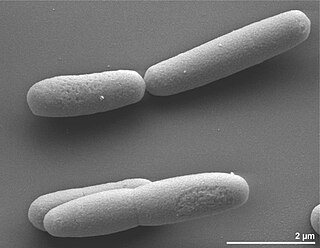Related Research Articles

Nitratidesulfovibrio vulgaris is a species of Gram-negative sulfate-reducing bacteria in the Desulfovibrionaceae family. It is also an anaerobic sulfate-reducing bacterium that is an important organism involved in the bioremediation of heavy metals in the environment. Nitratidesulfovibrio vulgaris is often used as a model organism for sulfur-reducing bacteria and was the first of such bacteria to have its genome sequenced. It is ubiquitous in nature and has also been implicated in a variety of human bacterial infections, although it may only be an opportunistic pathogen. This microbe also has the ability to endure high salinity environments, which is done through the utilization of osmoprotectants and efflux systems.
Desulfosporosinus is a genus of strictly anaerobic, sulfate-reducing bacteria, often found in soil.
Muricauda ruestringensis is a bacterium. It is a facultatively anaerobic, appendaged bacterium first isolated from the North Sea. Its nearest relative is Zobellia uliginosa. The type strain is strain B1T.
Desulfobulbus propionicus is a Gram-negative, anaerobic chemoorganotroph. Three separate strains have been identified: 1pr3T, 2pr4, and 3pr10. It is also the first pure culture example of successful disproportionation of elemental sulfur to sulfate and sulfide. Desulfobulbus propionicus has the potential to produce free energy and chemical products.

Oleidesulfovibrio alaskensis belongs to the sulfate-reducing bacteria. The type strain is Al1T.
Acidithiobacillus caldus formerly belonged to the genus Thiobacillus prior to 2000, when it was reclassified along with a number of other bacterial species into one of three new genera that better categorize sulfur-oxidizing acidophiles. As a member of the Gammaproteobacteria class of Pseudomonadota, A. caldus may be identified as a Gram-negative bacterium that is frequently found in pairs. Considered to be one of the most common microbes involved in biomining, it is capable of oxidizing reduced inorganic sulfur compounds (RISCs) that form during the breakdown of sulfide minerals. The meaning of the prefix acidi- in the name Acidithiobacillus comes from the Latin word acidus, signifying that members of this genus love a sour, acidic environment. Thio is derived from the Greek word thios and describes the use of sulfur as an energy source, and bacillus describes the shape of these microorganisms, which are small rods. The species name, caldus, is derived from the Latin word for warm or hot, denoting this species' love of a warm environment.
Desulfobacterium autotrophicum is a mesophilic sulfate-reducing bacterium. Its genome has been sequenced.
Syntrophobacter fumaroxidans is a species of syntrophic propionate-degrading sulfate-reducing bacterium. Strain MPOBT is the type strain. Its genome has been fully sequenced.

"Syntrophothermus lipocalidus" is a bacterium, the type species and only currently described species in its genus. It is thermophilic, syntrophic, fatty-acid-oxidizing and anaerobic, and utilises isobutyrate. TGB-C1T is its type strain. Its genome has been fully sequenced.
Holophaga foetida is a bacterium, the type species of its genus. It is a homoacetogenic bacterium degrading methoxylated aromatic compounds. It is gram-negative, obligately anaerobic and rod-shaped, with type strain TMBS4. Its genome has been sequenced. It is known for its ability to anaerobically degrade aromatic compounds and the production of volatile sulfur compounds through a unique pathway.
Dethiosulfovibrio peptidovorans is an anaerobic, slightly halophilic, thiosulfate-reducing bacterium. Its genome has been sequenced. It is vibrio-shaped, gram-negative and possesses lateral flagella. It is non-spore-forming. Its type strain is SEBR 4207T.
Haliangium ochraceum is a species of moderately halophilic myxobacteria. It produces yellow fruiting bodies, comprising several sessile sporangioles in dense packs. Its type strain is SMP-2. Its genome has been sequenced.
Glaciecola nitratireducens is a psychrophilic bacteria. It is Gram-negative, aerobic, rod-shaped, motile and halophilic. Its type strain is FR1064(T). Its genome has been sequenced.
Marinobacter lipolyticus is a moderate halophile with lipolytic activity. It is Gram-negative and rod-shaped, with type strain SM19T.
Sulfuricurvum kujiense is a facultatively anaerobic, chemolithoautotrophic, sulfur-oxidizing bacterium, the type species of its genus. Its cells are motile, curved rods and have a single polar flagellum. Its type strain is YK-1T.
Desulfurobacterium thermolithotrophum is a species of autotrophic, sulphur-reducing bacterium isolated from a deep-sea hydrothermal vent. It is the type species of its genus, being thermophilic, anaerobic, Gram-negative, motile and rod-shaped, with type strain BSAT.
Halorhodospira halophila is a species of Halorhodospira distinguished by its ability to grow optimally in an environment of 15–20% salinity. It was formerly called Ectothiorhodospira halophila. It is an anaerobic, rod-shaped Gram-negative bacterium. H. halophila has a flagellum.
Desulfohalobium is a Gram negative, anaerobic, sulfate-reducing, moderately halophilic and rod-shaped bacterial genus from the family of Desulfovibrionaceae.
Aminobacterium colombiense is a Gram-negative, mesophilic, strictly anaerobic and non-spore-forming bacterium from the genus of Aminobacterium which has been isolated from anaerobic lagoon from a dairy wastewater treatment plant in Colombia.

Halanaerobium praevalens is a moderately alkaliphilic, extremely halophilic bacterium that was first isolated from surface sediments of the Great Salt Lake, Utah and described by J.G. Zeikus et al. in 1983, with IJSB validation in 1984.
References
- ↑ Ollivier, B.; Hatchikian, C. E.; Prensier, G.; Guezennec, J.; Garcia, J.-L. (1991). "Desulfohalobium retbaense gen. nov., sp. nov., a Halophilic Sulfate-Reducing Bacterium from Sediments of a Hypersaline Lake in Senegal". International Journal of Systematic Bacteriology. 41 (1): 74–81. doi: 10.1099/00207713-41-1-74 . ISSN 0020-7713.
- ↑ Spring, Stefan; Nolan, Matt; Lapidus, Alla; Glavina Del Rio, Tijana; Copeland, Alex; Tice, Hope; Cheng, Jan-Fang; Lucas, Susan; Land, Miriam; Chen, Feng; Bruce, David; Goodwin, Lynne; Pitluck, Sam; Ivanova, Natalia; Mavromatis, Konstantinos; Mikhailova, Natalia; Pati, Amrita; Chen, Amy; Palaniappan, Krishna; Hauser, Loren; Chang, Yun-Juan; Jeffries, Cynthia D.; Munk, Christine; Kiss, Hajnalka; Chain, Patrick; Han, Cliff; Brettin, Thomas; Detter, John C.; Schüler, Esther; Göker, Markus; Rohde, Manfred; Bristow, Jim; Eisen, Jonathan A.; Markowitz, Victor; Hugenholtz, Philip; Kyrpides, Nikos C.; Klenk, Hans-Peter (2010). "Complete genome sequence of Desulfohalobium retbaense type strain (HR100T)". Standards in Genomic Sciences. 2 (1): 38–48. doi:10.4056/sigs.581048. ISSN 1944-3277. PMC 3035252 . PMID 21304676.